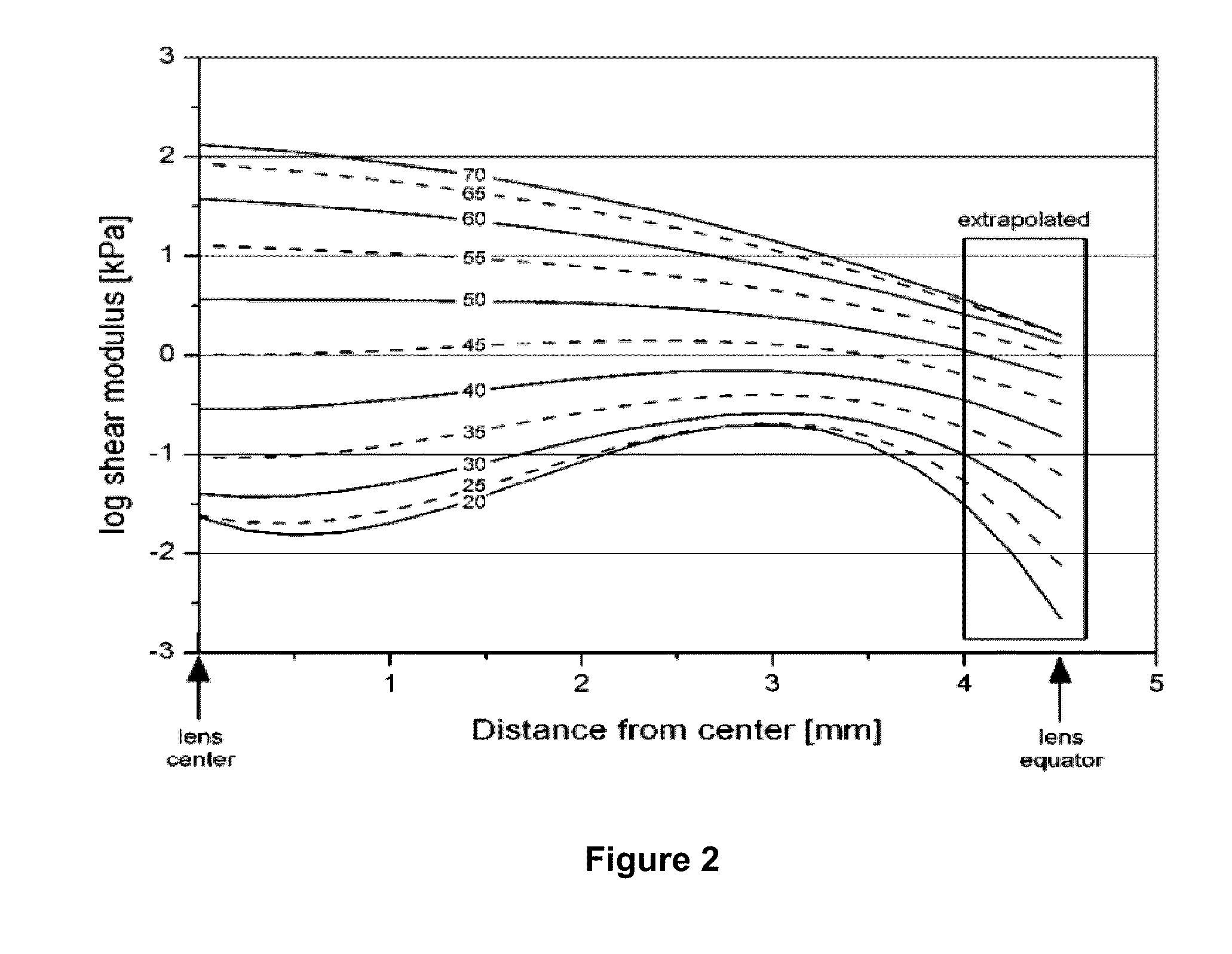Methods of treating ocular diseases using derivatives of lipoic acid
a technology of lipoic acid and ocular disease, which is applied in the field of methods of treating ocular diseases using lipoic acid derivatives, can solve the problem of more difficult to focus on near objects
- Summary
- Abstract
- Description
- Claims
- Application Information
AI Technical Summary
Benefits of technology
Problems solved by technology
Method used
Image
Examples
example 1
[0197]Increase in Elasticity: Pairs of mouse lenses were incubated in medium 200 supplemented with an antibiotic, an antimycotic, in the presence or absence of lipoic acid (concentrations ranging from 0.5 μM to 500 μM) for 8-15 hours. Each lens was removed from medium, weighed, and photographed on a micrometer scale. A coverslip of known weight (0.17899±0.00200 g) was placed on the lens, and the lens was photographed again on the micrometer scale. The diameter of each lens with and without the coverslip was determined from the photographs. The change in lens diameter produced by the force (coverslip) was computed ΔD=(Dwithcoverslip−Dwithoutcoverslip). The results (FIG. 4, ‡) indicate that lipoic acid at concentrations ≧9.6 μM caused a statistically significant increase in ΔD, p<0.0001.
[0198]Decrease in disulfide bonds: Lipoic acid at concentrations ≧9.6 μM caused a statistically significant decrease in protein disulfides in the mouse lenses where there was a...
example 2
Synthesis of (R)-Lipoamide
[0199]NHS ester of (R)-lipoic acid. The NHS ester of (R)-lipoic acid was synthesized as described in Scheme 1 following.
[0200]
[0201]A solution of lipoic acid (25.6 g, 124 mmol), N-hydroxysuccinimide (15.6 g, 136 mmol), and EDC (26.1 g, 136 mmol) in anhydrous CH2Cl2 (300 mL) was stirred overnight at room temperature. The reaction mixture was diluted with ethyl acetate (500 mL) and washed with H2O (500 mL), saturated aqueous NaHCO3 (500 mL), saturated aqueous NaCl (500 mL) and dried (MgSO4). The drying agent was removed by filtration and the filtrate was concentrated to dryness giving the product as a yellow sold (35.4 g, 94%).
[0202](R)-Lipoamide. (R)-lipoamide was synthesized as described in Scheme 2 following.
[0203]
[0204]A solution of the NHS ester (2.7 g, 8.9 mmol) in anhydrous CH2Cl2 (50 mL) was cooled in a dry ice acetone bath. Ammonia was condensed into the reaction mixture over a period of 1-2 hours, then the reaction mixture was allowed to warm to roo...
example 3
Synthesis of an Arginine-Lipoic Acid Conjugate (“LA-Arg”)
[0205]Pentafluorophenyl ester of (R)-lipoic acid. The pentafluorophenyl ester of (R)-lipoic acid was synthesis as described in Scheme 3 following.
[0206]
[0207]Solid EDC (1.04 g, 5.4 mmol) was added at once to a solution of lipoic acid (1.0 g, 4.8 mmol), and pentafluorophenol (1 g, 5.4 mmol) in anhydrous CH2Cl2:DMF (14 mL; (6:1)). The solution was stirred overnight at room temperature then concentrated to dryness. Flash column chromatography (SiO2, 100% DCM) afforded the product as a clear, thick yellow oil (1.67 g, 94%).
[0208]LA-Arg. The arginine-lipoic acid conjugate was synthesis as described in Scheme 4 following.
[0209]
[0210]L-Arginine (530 mg, 3.1 mmol) was added at once to a solution of the Pfp ester (1.34 g, 3.6 mmol) in anhydrous DMF (4 mL). The reaction mixture was stirred at room temperature for 48 hours. Insolubles were isolated by vacuum filtration and the filter cake was washed with CHCl3 (20 mL). The material was d...
PUM
| Property | Measurement | Unit |
|---|---|---|
| diameter | aaaaa | aaaaa |
| structure | aaaaa | aaaaa |
| oxidative stress | aaaaa | aaaaa |
Abstract
Description
Claims
Application Information
 Login to View More
Login to View More - R&D
- Intellectual Property
- Life Sciences
- Materials
- Tech Scout
- Unparalleled Data Quality
- Higher Quality Content
- 60% Fewer Hallucinations
Browse by: Latest US Patents, China's latest patents, Technical Efficacy Thesaurus, Application Domain, Technology Topic, Popular Technical Reports.
© 2025 PatSnap. All rights reserved.Legal|Privacy policy|Modern Slavery Act Transparency Statement|Sitemap|About US| Contact US: help@patsnap.com



